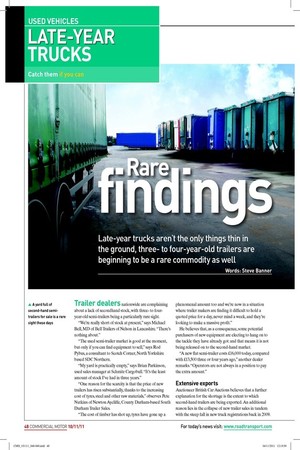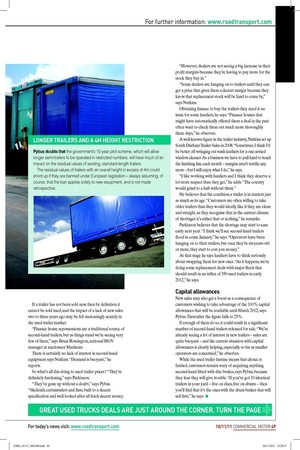ndings
Page 40

Page 41

If you've noticed an error in this article please click here to report it so we can fix it.
Late-year trucks aren’t the only things thin in the ground, threeto four-year-old trailers are beginning to be a rare commodity as well Words: Steve Banner Trailer dealers nationwide are complaining about a lack of secondhand stock, with threeto fouryear-old semi-trailers being a particularly rare sight.
“We’re really short of stock at present,” says Michael Bell, MD of Bell Trailers of Nelson in Lancashire. “There’s nothing about.” “The used semi-trailer market is good at the moment, but only if you can ind equipment to sell,” says Rod Pybus, a consultant to Scotch Corner, North Yorkshire based SDC Northern.
“My yard is practically empty,” says Brian Parkinson, used sales manager at Schmitz Cargobull. “It’s the least amount of stock I’ve had in three years.” “One reason for the scarcity is that the price of new trailers has risen substantially, thanks to the increasing cost of tyres, steel and other raw materials,” observes Pete Nutkins of Newton Aycliffe, County Durham-based South Durham Trailer Sales.
“The cost of timber has shot up, tyres have gone up a phenomenal amount too and we’re now in a situation where trailer makers are inding it dificult to hold a quoted price for a day, never mind a week, and they’re looking to make a massive proit.” He believes that, as a consequence, some potential purchasers of new equipment are electing to hang on to the tackle they have already got: and that means it is not being released on to the second-hand market.
“A new lat semi-trailer costs £16,000 today, compared with £13,500 three or four years ago,” another dealer remarks. “Operators are not always in a position to pay the extra amount.”
Extensive exports
Auctioneer British Car Auctions believes that a further explanation for the shortage is the extent to which second-hand trailers are being exported. An additional reason lies in the collapse of new trailer sales in tandem with the steep fall in new truck registrations back in 2009. If a trailer has not been sold new, then by deinition it cannot be sold used, and the impact of a lack of new sales two to three years ago may be felt increasingly acutely in the used trailer market.
“Finance house repossessions are a traditional source of second-hand trailers, but as things stand we’re seeing very few of them,” says Brian Rossington, national HGV manager at auctioneer Manheim.
There is certainly no lack of interest in second-hand equipment says Nutkins. “Demand is buoyant,” he reports.
So what’s all this doing to used trailer prices? “They’re deinitely hardening,” says Parkinson.
“They’ve gone up without a doubt,” says Pybus. “Skeletals, curtainsiders and lats, built to a decent speciication and well looked after all fetch decent money. “However, dealers are not seeing a big increase in their proit margins because they’re having to pay more for the stock they buy in.” “Some dealers are hanging on to trailers until they can get a price that gives them a decent margin because they know that replacement stock will be hard to come by,” says Nutkins.
Obtaining inance to buy the trailers they need is an issue for some hauliers, he says. “Finance houses that might have automatically offered them a deal in the past often want to check them out much more thoroughly these days,” he observes.
A well-known igure in the trailer industry, Nutkins set up South Durham Trailer Sales in 2008. “Sometimes I think I’d be better off wringing out wash leathers for a one-armed window cleaner. As a business we have to pull hard to reach the inishing line each month – margins aren’t terriic any more – but I still enjoy what I do,” he says.
“I like working with hauliers and I think they deserve a lot more respect than they get,” he adds. “The country would grind to a halt without them.” He believes that the condition a trailer is in matters just as much as its age. “Customers are often willing to take older trailers than they would ideally like if they are clean and straight, as they recognise that in the current climate of shortages it’s either that or nothing,” he remarks.
Parkinson believes that the shortage may start to ease early next year. “I think we’ll see second-hand trailers lood in come January,” he says. “Operators have been hanging on to their trailers, but once they’re six-years-old or more, they start to cost you money.” At that stage he says hauliers have to think seriously about swapping them for new ones. “As it happens, we’re doing some replacement deals with major leets that should result in an inlux of 350 used trailers in early 2012,” he says.
Capital allowances
New sales may also get a boost as a consequence of customers wishing to take advantage of the 100% capital allowances that will be available until March 2012, says Pybus. Thereafter the igure falls to 25%.
If enough of them do so, it could result in a signiicant number of second-hand trailers released for sale. “We’re already seeing a lot of interest in new trailers – sales are quite buoyant – and the current situation with capital allowances is clearly helping, especially so far as smaller operators are concerned,” he observes.
While the used trailer famine means that choice is limited, customers remain wary of acquiring anything second-hand itted with disc brakes, says Pybus, because they fear they will give trouble. “If you’ve got 10 identical trailers in your yard – ive on discs, ive on drums – then you’ll ind that it’s the ones with the drum brakes that will sell irst,” he says. ■











































